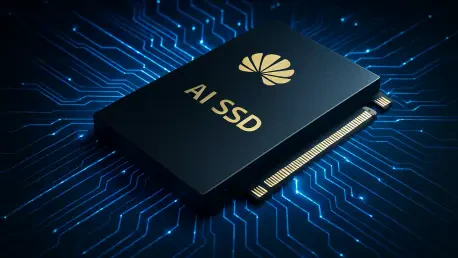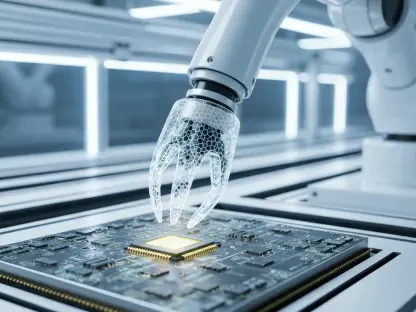In an era where artificial intelligence workloads are pushing the boundaries of computational infrastructure, memory bottlenecks have emerged as a critical challenge for tech giants and data centers alike, stalling progress in training massive language models due to insufficient memory capacity or the skyrocketing costs of high-bandwidth solutions. Huawei has stepped into this high-stakes arena with a bold innovation—AI-focused Solid State Drives (SSDs) designed to shatter these barriers. This strategic move not only addresses the pressing “memory wall” but also positions the company as a key player in redefining storage solutions for AI, sparking curiosity about how such technology could transform the industry landscape.
Huawei’s Pioneering AI SSD Solutions
Tackling the Memory Barrier: Innovations and Market Trends
The AI ecosystem faces significant hurdles known as the “memory wall” and “capacity wall,” where the demand for rapid data access and vast storage outpaces traditional memory technologies like High-Bandwidth Memory (HBM). With HBM costs soaring and supply constraints tightening due to geopolitical factors such as U.S. export controls, companies are scrambling for alternatives. Huawei’s response comes in the form of its OceanDisk series, including the EX, SP, and LC 560 drives, which offer groundbreaking specs like the LC 560’s staggering 245TB capacity and 14.7GB/s read bandwidth, setting a new benchmark for storage in AI applications.
This innovation aligns with a broader industry trend where the need for high-capacity storage is surging, driven by the exponential growth of data in AI training and inference tasks. Reports indicate that data centers are increasingly seeking solutions that balance performance with affordability, a niche Huawei aims to fill. By leveraging domestic NAND flash technology, the company not only circumvents external supply chain dependencies but also taps into a growing market demand for scalable, high-performance storage options tailored for AI workloads.
Practical Impacts: Use Cases for AI SSDs
Huawei’s OceanDisk lineup is engineered for specific AI scenarios, demonstrating versatility across diverse applications. The OceanDisk EX 560, with its extreme performance metrics, enables fine-tuning of large language models by supporting six times more tunable parameters on a single machine, making it invaluable for research labs and tech firms developing cutting-edge AI. Meanwhile, the SP 560 targets cost-conscious inference tasks, slashing first-token latency by 75% and doubling throughput, ideal for real-time AI applications in sectors like customer service automation.
Beyond individual models, the LC 560 stands out for managing massive multimodal datasets, a critical need in cluster training environments where petabytes of data must be processed efficiently. Picture a global AI data center deploying these drives to handle video, text, and audio data simultaneously without performance hiccups. Such real-world scenarios underscore the practical relevance of Huawei’s solutions in addressing the storage demands of next-generation AI systems.
Complementing the hardware, Huawei introduces software innovations like DiskBooster, which can expand pooled memory capacity by up to 20 times through seamless coordination with HBM and DDR memory. Additionally, multi-stream technology minimizes write amplification to enhance drive longevity. These tools provide a robust framework for ensuring that the SSDs deliver sustained value in high-pressure AI environments, though their success hinges on effective integration with existing infrastructure.
Industry Insights on Huawei’s Storage Approach
Huawei’s leadership has been vocal about the urgency of addressing IT infrastructure challenges in the AI era. Zhou Yuefeng, vice-president and head of the data storage product line, has emphasized that innovative solutions are essential to sustain the AI business cycle amid rising costs and performance demands. This perspective reflects a strategic vision to position SSDs as a viable complement to HBM, reducing dependency on constrained memory technologies while maintaining computational efficiency.
Analysts and industry experts offer a balanced view on this approach, noting a growing trend toward diversified storage-memory architectures as a way to mitigate HBM scarcity. While SSDs show promise in handling certain AI workloads, skepticism remains about their ability to fully replace HBM in the most intensive tasks, such as large-scale language model training. The consensus leans toward cautious optimism, acknowledging Huawei’s advancements but highlighting the need for real-world validation to confirm their impact on industry standards.
This nuanced outlook suggests that Huawei’s strategy could inspire a shift in how storage and memory are conceptualized in AI systems. As companies worldwide grapple with similar supply chain limitations, the focus on system-level integration and alternative technologies might encourage broader adoption of hybrid solutions. However, the untested nature of fully offsetting HBM limitations keeps expectations grounded, with many awaiting performance data from live deployments.
Looking Ahead: The Evolution of AI Storage Solutions
Huawei’s emphasis on domestic NAND flash and system-level integration could set a precedent for global AI infrastructure, particularly in regions facing supply chain disruptions. By prioritizing homegrown technology, the company may influence trends toward self-reliance in critical tech components, potentially reshaping procurement strategies for data centers from 2025 onward. This shift could lower barriers for AI development in constrained markets, offering a blueprint for others to follow.
Yet, challenges loom on the horizon, including scalability concerns and compatibility with diverse AI frameworks. Ensuring that these SSDs perform consistently across varied systems remains a hurdle, as does validating their effectiveness in real-world conditions beyond controlled testing. Despite these obstacles, the benefits—such as reduced reliance on expensive HBM and potential cost savings—present a compelling case for continued investment in SSD-based architectures.
The broader implications of this trend extend to fostering competition and innovation in the AI storage space. If Huawei’s approach proves successful, it might prompt rivals to explore similar pathways, accelerating the development of cost-effective memory solutions. However, integration complexities and the risk of performance gaps could temper enthusiasm, underscoring the importance of rigorous testing and adaptation to ensure that such innovations deliver on their promise.
Final Reflections on Huawei’s AI Storage Journey
Reflecting on Huawei’s foray into AI SSDs, it becomes clear that the OceanDisk series marks a pivotal response to HBM scarcity, with standout features like the LC 560’s 245TB capacity and software optimizations such as DiskBooster redefining storage capabilities. The strategic push to address both technical and geopolitical challenges through innovative drives highlights a critical moment in sustaining AI growth. As the industry observes, these advancements offer a glimpse into alternative architectures that could support complex workloads.
Moving forward, stakeholders are encouraged to closely track Huawei’s real-world performance outcomes, focusing on how these SSDs integrate into existing systems and deliver measurable gains. Collaborative efforts between tech providers and data center operators could refine these solutions, addressing scalability and compatibility issues. Additionally, investing in pilot programs to test SSD-driven AI setups is seen as a practical step to validate their transformative potential, paving the way for broader adoption in the evolving landscape of AI infrastructure.









